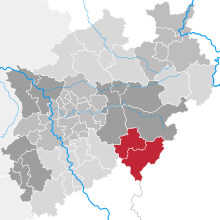Verkehrsgemeinschaft Westfalen-Süd
The traffic community Westphalia south (VGWS) was on 1. January 1975 as an association of all the public transport (LPT) in the districts of Siegen-Wittgenstein and Olpe participating transport companies established. It was their job to ensure a uniform tariff and coordinated timetables .
Object carrier are for rail transport (SPNV) in co-operation area 8 (Westphalia south) the purpose association transport Westphalia South (CFB) for the road passenger transport (public road transport) , the two circuits. This regulation is also retained in the Westphalian tariff.
In the area of the former VGWS, the first drive of a gasoline-powered bus by the Netphener Omnibus Company took place on March 18, 1895 .
The traffic area with an area of around 1,850 km² bordered on the Ruhr-Lippe Transport Association (VRL) in the north, the North Hessian Transport Association (NVV) in the east, the Rhein-Main Transport Association (RMV) in the southeast, and the Transport Association in the southwest Rhein-Mosel (VRM) and in the west to the Verkehrsverbund Rhein-Sieg (VRS).
On August 1, 2017, the tariff of the Verkehrsgemeinschaft Westfalen-Süd was canceled and merged with the Ruhr-Lippe tariff , the Münsterland tariff , the Hochstift tariff and the tariffs from the six to the new Westphalian tariff .
Cities and municipalities in the traffic area of the VGWS
- Attendorn
- Bad Berleburg
- Bad Laasphe
- Burbach
- Drolshagen
- Erndtebrück
- Finnentrop
- Freudenberg
- Hilchenbach
- Kirchhundem
- Kreuztal
- Lennestadt
- Netphen
- Neunkirchen
- Olpe
- Wins
- Turn
- Wilnsdorf
In addition, there are VGWS transition tariff zones for cross-border trips to Hesse and Rhineland-Palatinate .
In the RMV area:
In the NVV area:
In the VRM area:
If there are no other transitional regulations, the NRW tariff applies within NRW .
Transport companies in the VGWS
- At the beginning only the VWS Verkehrsbetriebe Westfalen-Süd in Siegen , the Westfalenbus from Münster and the bus company Albert Schmidt from Hilchenbach- Dahlbruch belonged to the Verkehrsgemeinschaft Westfalen Süd .
- The Albert Schmidt company left the company in the 1990s to close down.
- Later, other partners were added: DB Regio NRW , DB Dreiländerbahn (2004–2014), Hellertalbahn GmbH (1999–2014) (subsidiary of HLB , KSW and WEBA ).
- On January 1, 2002, Westfalenbus reduced its traffic area for financial reasons, but founded subsidiaries such as Busverkehr Ruhr-Sieg , which, among other things, serves the traffic area Westphalia-South. On November 1st, 2008 it was merged with the other Westphalian rail bus companies and is now called DB Bahn Westfalenbus .
- Abellio Rail NRW joined the VGWS in December 2007 because it won the tenders on the Ruhr-Sieg network (RE16 / RB40 / RB91).
- The Westerwaldbahn GmbH (WEBA) also recognized VGWS tickets on the Daadetalbahn (RB97).
- In December 2010, replacing DB Regio Rheinland the DB Regio NRW on the line RE9. In the summer of 2011, however, this was incorporated into the DB Regio NRW. The train route operates under the name Rhein-Sieg-Express (RSX).
- Furthermore, the Hessische Landesbahn (HLB) joined VGWS in December 2010 with the takeover of the RE99 line (Siegen - Gießen - Frankfurt). From December 2014 it also operated the regional trains in the Eifel-Westerwald-Sieg diesel network.
- The last member to join was Verkehrsgesellschaft Lahn-Dill-Weil mbH (VLDW); these had won tenders in the Olpe area.
See also
Web links
- Internet presence of the Verkehrsgemeinschaft Westfalen-Süd
- Special purpose association for local passenger transport Westphalia South
- Traffic portal for bus and train traffic in the NRW cooperation area Westphalia-South
Individual evidence
- ↑ Founding of the company for the Westphalian tariff decided. In: nwl-info.de. Zweckverband Nahverkehr Westfalen-Lippe , March 30, 2016, accessed on May 22, 2016 .
